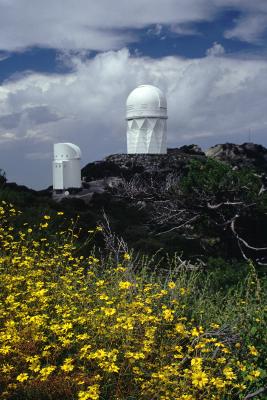View Larger Map

Located atop the Quinlan Mountains in an absolutely spectacular setting is the national observatory of Kitt Peak. Home to over thirty telescopes and other astronomical instruments from modest scopes to the 4m Mayall and the 3.5m WIYN telescope.
The summit of Kitt Peak is 2095m (6875ft) and offers views of the surrounding desert that are worth the drive if not observing. A visit makes an excellent day trip, just pack a picnic lunch and visit the telescopes of the mountain.
For observing the mountain is hard to match with dark, transparent skies with very steady seeing. Unfortunately for us amateurs the professionals tend to keep the mountain to themselves. The public is asked to depart the mountain each night with the exception of the Nightly Observing Program (see below) and semi-annual TAAA club events.
While physical access is excellent with a paved highway up the mountain, the site is not usually available to the public for observing. All visitors must leave the mountain at 4:00pm unless they are there for the nightly observing program. Reservations for the program are limited and often filled months in advance for dark-of-the-Moon nights. See links below for more information. One exception to this is the Kitt Peak star parties arranged by the TAAA twice a year for it's members. Sign-up is limited and very popular, and takes place at the TAAA main meeting prior to the event. The dates can be found on the TAAA calendar page. These events are half night and participants must depart around 11:00pm.
Links
Observing for the nightly program uses a 20" RC in a dome adjacent to the visitor center atop the mountain. A 16" LX200 is also available in a dome on the south end of the mountain for the advanced program. TAAA star parties use the picnic ground where tables, a ramada, water and bathrooms are available. Cell phone use is not allowed to avoid interference with nearby radio telescopes.